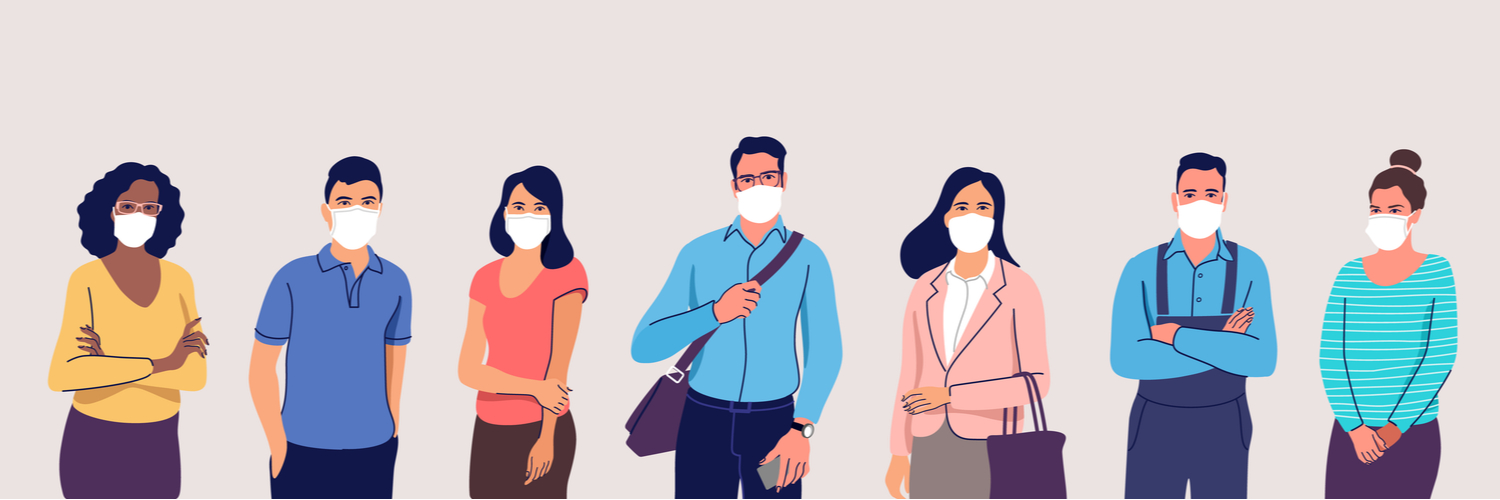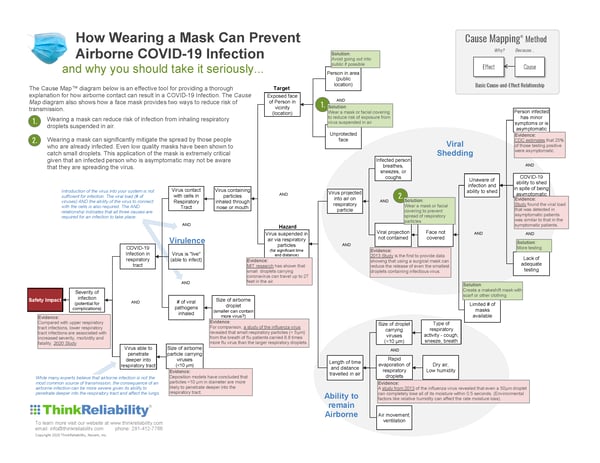Most of us have seen the recent change in guidelines around the use of masks or scarves to cover our faces in public. What is the reason for this recent reversal in guidelines? In my series of blogs on the COVID-19 pandemic, I’ve used our Cause Mapping® method to thoroughly explain the specific cause-and-effect relationships that play a critical role in transmission and infection of the virus.
In this blog, I use the Cause Map™ diagram to reveal why a face covering of any kind can play a critical role in reducing airborne transmission. You may be surprised at how it reduces the risk.
My previous blog focused on explaining surface transmission of COVID-19 and the many things you can do to reduce your risk. As we dig into airborne transmission, we see the same fundamental relationship required for being infected. In order for a virus to cause infection, it must enter and make contact with the cells within your respiratory tract.
Exposure to the Virus Requires Two Causes
The most common routes of virus entry are through your nose and mouth. Airborne contact through your nose or mouth requires two causes: the virus must be suspended in the air AND your exposed face must be at the same location. As the causal relationships demonstrate below, both causes are required. If you take away either one, you can’t have an airborne contact and transmission.
In the below graphic, we see a visual representation of the cause-and-effect relationships involved in this viral contact. To read it, start on the left side and ask Why? So, in this instance, "COVID-19 Infection in respiratory tract." Why? Because the virus made contact with cells in the respiratory tract. We can continue reading from left to right following this pattern. See below.
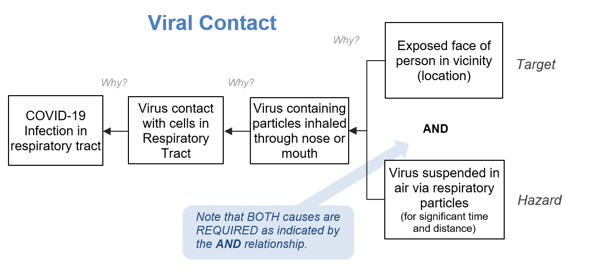
This fundamental relationship is important because it highlights two ways to reduce risk. By controlling either cause, you can reduce the risk of becoming infected by the deadly virus. An obvious solution here is to avoid public locations as much as possible. And, if you must go out in public, then another option to consider is to protect yourself from airborne contact by covering your mouth and nose.
Up until recently, experts have recommended against this tactic by arguing that unless you use the proper mask, with the proper fit, you can still contract the virus. While that is true, even something simple like a scarf will provide a barrier to entry, especially if you’re in the vicinity of larger respiratory particles.
One Sneeze Can Produce 20,000 Droplets
Let’s look at the other cause required in this fundamental relationship of contact: the infectable virus must be suspended in the air. For this to happen, it must be projected from someone who has the infection. To be more specific, every time you sneeze, cough, or even breathe, you project respiratory droplets. If you’re infected, the virus rides along on these droplets. The number and size of droplets varies based upon the respiratory action. For example, one sneeze can produce 20,000 droplets, in contrast to several hundred droplets from a cough. The largest and heaviest droplets fall to the ground—typically, within a six-foot radius. This helps explains the six-foot social distancing recommendations. However, the smallest droplets, those less than 10μm in diameter can stay suspended in air.
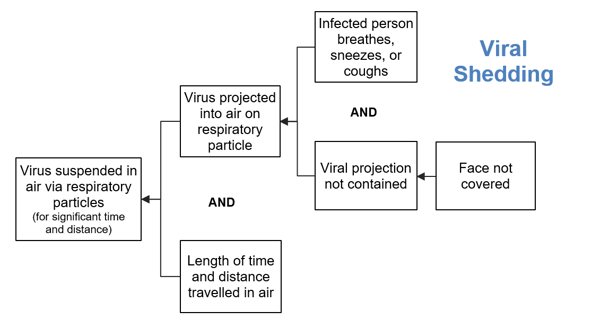
Virus Ability to Remain Airborne
Another concern with airborne transmission is its ability to penetrate deeper into the respiratory tract. Lower tract infections are associated with increased severity and morbidity. So, it’s important to understand how long they are suspended and the distances they can travel. As you can see on the Cause Map diagram below, the ability to remain airborne is based on several factors, including the initial size of the droplet along with the fact that as soon as it is expelled, it immediately begins to lose moisture. A study from 2013 of the influenza virus revealed that even a 50μm droplet can completely lose all of its moisture within 0.5 seconds. (Environmental factors like relative humidity can affect the rate moisture loss. See my previous blog here for details.) Now with less weight, the virus can remain suspended in air for longer periods of time. Research has shown that these airborne particles can stay suspended in air and can travel a distance up to 27 feet given the right conditions. Although, just because the virus is in the air and traveling, that does not necessarily mean that the virus is still viable enough to infect.
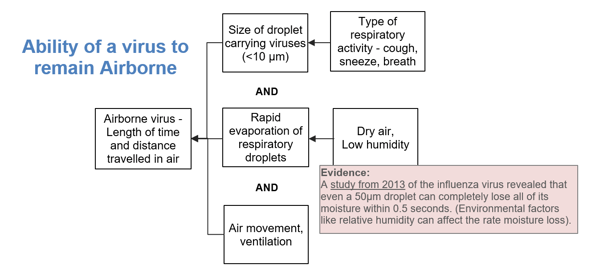
Another concern is the number of viruses that catch a ride with these respiratory droplets. For comparison, a study of the influenza virus revealed that small respiratory particles (< 5μm) from the breath of flu patients carried 8.8 times more flu virus than the larger respiratory droplets—not exactly what you would expect. This fact, along with the ability for smaller droplets to stay suspended in air and travel over long distances, increases our risk of contact.
Two Benefits of Wearing a Mask
Now, here’s where the wearing of masks comes in: this risk can be significantly reduced by containing at the source (infected person). A major benefit of a facial covering is to keep an infected person from projecting the virus.
The same 2013 study showed that using a simple surgical mask can reduce the release of even the smallest droplets. Covering your face is more effective if you’re infected rather than if worn by those who are uninfected—for airborne and surface contact. So why ask that everyone covers their faces? Because one of the unique challenges with COVID-19 is that many of those who are infected don’t know it. It is estimated that 25 percent of those infected are asymptomatic, and yet still have the ability to spread the virus (according to this March 2020 study). Ironically, by wearing a facial covering to protect yourself, you may be protecting others. As the Cause Map diagram shows below, the same solution (wearing a mask) controls two different causes, which means it can reduce the risk of spreading the virus in two ways:
- It helps the uninfected person avoid contact with the virus, and
- It can significantly mitigate the spread by those people who are already infected.
Now that I have you officially freaked out, let me highlight one bit of good news. The virus making contact within your respiratory tract is not sufficient to cause infection. As demonstrated on the Cause Map diagram below, the viral load (the number of virus particles taken in), the ability for the virus to enter your respiratory system AND the virus connecting with your cells are all required to become infected (you can see this with the AND relationship on the Cause Map diagram when you download the pdf). So, while you could possibly inhale an airborne particle carrying the virus, the longer it is away from its host, the more likely it is to lose its virulence (ability to infect).
By clicking the image above, you can download a copy of the PDF with the completed Cause Map diagram for airborne infection highlighting the two benefits of covering your face.
This is the third blog in a series around the COVID-19 pandemic. I’ll discuss how all three blogs come together in a free, 45-minute webinar on April 9, 2020.
On the webinar, I’ll use the Cause Map diagram to cover the complex system of causes that are required to become infected. In addition, I’ll provide a PDF of the complete, detailed Cause Map diagram for the COVID-19 infection.

